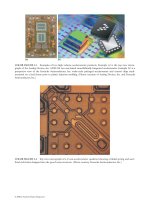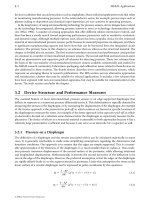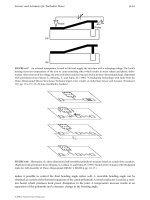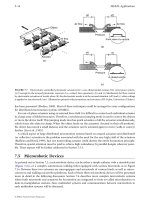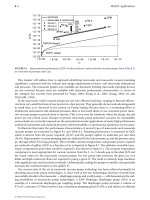Engineering Materials Vol II (microstructures_ processing_ design) 2nd ed. - M. Ashby_ D. Jones (1999) WW Part 14 ppsx
Bạn đang xem bản rút gọn của tài liệu. Xem và tải ngay bản đầy đủ của tài liệu tại đây (1.6 MB, 27 trang )
342 Engineering Materials 2
(c) If pressure is held fixed at atmospheric pressure, there are at most
––––––
degrees of freedom.
(d) If F = 0, how many phases can coexist in equilibrium at constant p?
––––––
(e) If F = 1, how many phases coexist at constant p?
–––––––––––––––––
(f) If F = 2, how many phases coexist at constant p?
–––––––––––––––––
(g) In a single-phase field, how many degrees of freedom are there at constant p?
––––––––––––––––––––––––––––––––––––––––––––––
(h) In a two-phase field, how many degrees of freedom are there at constant p?
––––––––––––––––––––––––––––––––––––––––––––––
Part 2: final question
2.12 Figure A1.19 shows the phase diagram for the copper–zinc system. It is more
complicated than you have seen so far, but all the same rules apply. The Greek
letters (conventionally) identify the single-phase fields.
Fig. A1.19.
(a) Shade in the two-phase fields. Note that single-phase fields are always separ-
ated by two-phase fields except at points.
(b) The two common commercial brasses are:
70/30 brass: W
Cu
= 70%;
60/40 brass: W
Cu
= 60%.
Mark their constitution points onto the diagram at 200°C (not much happens
between 200°C and room temperature).
What distinguishes the two alloys?
–––––––––––––––––––––––––
(c) What, roughly, is the melting point of 70/30 brass?
–––––––––––––––
Teaching yourself phase diagrams 343
2.4 (See Fig. A1.21.)
(d) What are the phase(s) in 60/40 brass at 200°C?
––––––––––––––––––
What are the phase(s) in 60/40 brass at 800°C?
––––––––––––––––––
What has happened to the other phase?
––––––––––––––––––––––
Answers to questions: part 2
2.1 Crystalline solid, liquid and vapour.
2.2 It increases.
2.3 (See Fig. A1.20.)
Fig. A1.21.
Fig. A1.20.
344 Engineering Materials 2
2.5 (a) Tin-rich solid plus lead-rich solid.
(b) Liquid plus tin-rich solid.
(c) Lead-rich solid only.
(d) Liquid only.
2.6 (a) Liquid plus lead-rich solid between 1 and 2.
(b) Lead-rich solid between 2 and 3.
(c) Lead-rich solid plus tin-rich solid below 3 (see Fig. A1.22).
2.7 Ice VI at the core, ice II nearer the surface, ice I at the surface, possibly a thin shell
of ice V between ice II and ice VI.
2.8 (a) Liquid plus lead-rich solid at 250°C
X
Pb
= 53% in the liquid
X
Pb
= 79% in the solid.
(b) Liquid plus lead-rich solid at 200°C
X
Pb
= 33% in the liquid
X
Pb
= 73% in the solid.
(c) Tin-rich solid plus lead-rich solid at 150°C
X
Pb
= 1% in the tin-rich solid
X
Pb
= 83% in the lead-rich solid.
(d) (See Fig. A1.23.)
Fig. A1.22.
Fig. A1.23.
Teaching yourself phase diagrams 345
The compositions of the phases can change provided that their relative proportions
change so as to lead to the same overall alloy composition. In practice changes in
phase composition occur by diffusion.
2.9 (a) Liquid.
(b) Solid.
See Fig. A1.24.
Fig. A1.24.
2.10 (a) 2.
(b) W
Pb
= 2%, W
Pb
= 90%.
(c) The lead-rich solid.
(d) Tin-rich solid 11% of total weight.
Lead-rich solid 89% of total weight (see Fig. A1.24).
2.11 (a) C = 2.
(b) Intensive variables p, T, X
B
or X
A
.
(c) 2.
(d) 3.
(e) 2.
(f) 1.
(g) 2.
(h) Only 1. The compositions of the phases are given by the ends of the tie-lines
so that T and X
B
(or X
A
) are dependent on one another.
2.12 (a) See Fig. A1.25.
(b) 70/30 brass is single-phase, but 60/40 brass is two-phase.
(c) 70/30 brass starts to melt at 920°C and is completely liquid at 950°C. 60/40
brass starts to melt at 895°C and is completely liquid at 898°C.
(d) At 200°C:
α
(copper-rich solid) and
β
(roughly CuZn).
At 800°C:
β
.
The
α
has dissolved in the
β
.
346 Engineering Materials 2
Fig. A1.25.
Fig. A1.26.
T
EACHING
YOURSELF
PHASE
DIAGRAMS
,
PART
3
EUTECTICS
,
EUTECTOIDS
AND
PERITECTICS
Eutectics and eutectoids are important. They are common in engineering alloys, and
allow the production of special, strong, microstructures. Peritectics are less important.
But you should know what they are and what they look like, to avoid confusing them
with other features of phase diagrams.
Eutectics
The Pb–Sn system has a eutectic. Look at the Pb–Sn phase diagram (Fig. A1.26). Above
327°C, liquid lead and liquid tin are completely miscible, that is, the one dissolves in the
other completely. On cooling, solid first starts to appear when the lines (or boundaries)
which limit the bottom of the liquid field are reached.
Teaching yourself phase diagrams 347
DEF. The phase boundary which limits the bottom of the liquid
field is called the liquidus line. The other boundary of the
two-phase liquid–solid field is called the solidus line.
The liquidus lines start from the melting points of the pure components. Almost
always, alloying lowers the melting point, so the liquidus lines descend from the melt-
ing points of the pure components, forming a shallow V.
DEF. The bottom point of the V formed by two liquidus
lines is the eutectic point.
In the lead–tin system it is the point X
Pb
= 26.1 wt%, T = 183°C.
Most alloy systems are more complicated than the lead–tin system, and show inter-
mediate phases: compounds which form between components, like CuAl
2
, or Al
3
Ni, or
Fe
3
C. Their melting points are, usually, lowered by alloying also, so that eutectics can
form between CuAl
2
and Al (for example), or between Al
3
Ni and Al. The eutectic point
is always the apex of the more or less shallow V formed by the liquidus lines.
Figure A1.27 shows the unusual silver–strontium phase diagram. It has four inter-
metallic compounds. Note that it is just five simple phase diagrams, like the Pb–Sn
diagram, stuck together. The first is the Ag–SrAg
5
diagram, the second is the SrAg
5
–
Sr
3
Ag
5
diagram, and so on. Each has a eutectic. You can always dissect complicated
diagrams in this way.
Fig. A1.27.
Question
3.1 The three phase diagrams, or parts of diagrams, shown in Fig. A1.28, all have a
eutectic point. Mark the point with an arrow and list the eutectic temperature and
composition in wt% (the co-ordinates of the point).
348 Engineering Materials 2
Phase reactions
When an alloy is cooled the constitution point for the alloy drops vertically on the
phase diagram. In a single-phase field the composition of the phase is, of course, that
of the alloy. In a two-phase region the compositions of the two phases are related by
the tie line through the constitution point (p. 323: check it if you’ve forgotten); the
phase compositions are given by the two ends of the tie line. These do not (in general)
fall vertically; instead they run along the phase boundaries. The compositions of the
two phases then change with temperature.
DEF. When the compositions of the phases change with temperature,
we say that a phase reaction takes place.
Fig. A1.28.
Teaching yourself phase diagrams 349
Fig. A1.29.
Cooling without a phase reaction occurs:
(a) in a single-phase field,
(b) when both phase boundaries on either side of the constitution point are vertical.
Cooling with a phase reaction occurs when the constitution point lies in a two-phase
region, and at least one of the phase boundaries is not vertical.
Figure A1.29 shows the cooling of a lead–tin alloy with X
Pb
= 80%. On cooling from
350°C the following regimes appear.
1. From 350°C to 305°C. Single-phase liquid; no phase reaction.
2. From 305°C to 255°C. The liquidus line is reached at 305°C;
the reaction liquid → solid (Pb-rich solid solution) starts. The solid contains less tin
than the liquid (see first tie line), so the liquid becomes richer in tin and the composi-
tion of the liquid moves down the liquidus line as shown by the arrow. The composi-
tion of the solid in equilibrium with this liquid also changes, becoming richer in tin
also, as shown by the arrow on the solidus line: a phase reaction is taking place. The
proportion of liquid changes from 100% (first tie line) to 0% (second tie line).
3. From 255°C to 160°C. Single-phase solid, with composition identical to that of the
alloy. No phase reaction.
4. From 160°C to room temperature. The lead-rich phase becomes unstable when the
phase boundary at 160°C is crossed. It breaks down into two solid phases, with composi-
tions given by the ends of the tie line through point 4. On further cooling the composi-
tion of the two solid phases changes as shown by the arrows: each dissolves less of
the other. A phase reaction takes place. The proportion of each phase is given by the
lever rule. The compositions of each are read directly from the diagram (the ends of the
tie lines).
The eutectic reaction
Consider now the cooling of an alloy with 50 at% lead. Starting from 300°C, the
regions are shown in Fig. A1.30.
350 Engineering Materials 2
1. From 300°C to 245°C. Single-phase liquid; no phase reactions.
2. From 245°C to 183°C. The liquidus is reached at 245°C, and solid (a lead-rich solid
solution) first appears. The composition of the liquid moves along the liquidus line,
that of the solid along the solidus line. This regime ends when the temperature reaches
183°C. Note that the alloy composition in weight % (64) is roughly half way between
that of the solid (81 wt%) and liquid (38 wt%); so the alloy is about half liquid, half
solid, by weight.
3. At 183°C. The liquid composition has reached the eutectic point (the bottom of
the V). This is the lowest temperature at which liquid is stable. At this temperature all
the remaining liquid transforms to two solid phases: a tin-rich
α
phase, composition
X
Pb
= 1.45% and a lead-rich
β
phase, composition X
Pb
= 71%. This reaction:
Liquid →
α
+
β
at constant temperature is called a eutectic reaction.
DEF.A eutectic reaction is a three-phase reaction, by which,
on cooling, a liquid transforms into two solid phases
at the same time. It is a phase reaction, of course,
but a special one. If the bottom of a liquid-phase
field closes with a V, the bottom of the V is a
eutectic point.
At the eutectic point the three phases are in equilibrium. The compositions of the two
new phases are given by the ends of the line through the eutectic point.
4. From 183°C to room temperature. In this two-phase region the compositions and
proportions of the two solid phases are given by constructing the tie line and applying
the lever rule, as illustrated. The compositions of the two phases change, following
the phase boundaries, as the temperature decreases, that is, a further phase reaction
takes place.
Fig. A1.30.
Teaching yourself phase diagrams 351
Questions
3.2 Check, using the phase rule, that three phases can coexist only at a point (the
eutectic point) in the lead–tin system at constant pressure. If you have trouble,
revise the phase rule on p. 327.
3.3 Not all alloys in the lead–tin system show a eutectic: pure lead, for example, does
not. Examine the Pb–Sn phase diagram and list the composition range for which a
eutectic reaction is possible.
3.4 We defined a eutectic reaction (e.g. that of the lead–tin system) as a three-phase
reaction by which, on cooling, a liquid transforms into two solids. In general:
L →
α
+
β
5
or, for the lead–tin system 6 on cooling
Liquid (Pb–Sn) → (Pb) + (Sn) 7
What happens on heating?
Eutectic structure
The aluminium casting alloys are mostly based on the Al–Si system (phase diagram
Fig. A1.31). It is a classic eutectic system, with a eutectic point at about 11% Si and
Fig. A1.31.
352 Engineering Materials 2
577°C. Consider the cooling of an Al–6% Si casting alloy. The liquidus is reached at
about 635°C, when solid (Al) starts to separate out (top of Fig. A1.32). As the temper-
ature falls further the liquid composition moves along the liquidus line, and the amount
of solid (Al) increases. When the eutectic temperature (577°C) is reached, about half
the liquid has solidified (middle of Fig. A1.32). The solid that appears in this way is
called primary solid, primary (Al) in this case.
At 577°C the eutectic reaction takes place: the liquid decomposes into solid (Al)
mixed with solid Si, but on a finer scale than before (bottom of Fig. A1.32). This
intimate mixture of secondary (Al) with secondary Si is the eutectic structure.
On further cooling to room temperature the composition of the (Al) changes – it
dissolves less silicon at the lower temperature. So silicon must diffuse out of the (Al),
and the amount of Si must increase a little. But the final structure still looks like the
bottom of Fig. A1.32.
Dendrites
When a metal is cast, heat is conducted out of it through the walls of the mould. The
mould walls are the coldest part of the system, so solidification starts there. In the Al–Si
casting alloy, for example, primary (Al) crystals form on the mould wall and grow inwards.
Their composition differs from that of the liquid: it is purer, and contains less silicon.
This means that silicon is rejected at the surface of the growing crystals, and the liquid
grows richer in silicon: that is why the liquid composition moves along the liquidus line.
Fig. A1.32.
Teaching yourself phase diagrams 353
Fig. A1.33.
Fig. A1.34. Dendrites of silver in a copper–silver eutectic matrix, ×330. (After G. A. Chadwick,
Metallography
of Phase Transformations
, Butterworth, 1972.)
The rejected silicon accumulates in a layer just ahead of the growing crystals, and
lowers the melting point of the liquid there. That slows down the solidification, because
more heat has to be removed to get the liquid in this layer to freeze. But suppose a
protrusion or bump on the solid (Al) pokes through the layer (Fig. A1.33). It finds itself
in liquid which is not enriched with silicon, and can solidify. So the bump, if it forms,
is unstable and grows rapidly. Then the (Al) will grow, not as a sphere, but in a
branched shape called a dendrite. Many alloys show primary dendrites (Fig. A1.34); and
the eutectic, if it forms, fills in the gaps between the branches.
354 Engineering Materials 2
Segregation
If an 80 at% Pb alloy is cooled, the first solid appears at 305°C, and is primary (Pb)
with a composition of about 90% Pb (see Fig. A1.35). From 305 to 255°C the amount of
primary (Pb) increases, and its composition, which (at equilibrium) follows the solidus
line, changes: it becomes richer in tin. This means that lead must diffuse out of the
solid (Pb), and tin must diffuse in.
This diffusion takes time. If cooling is slow, time is available and equilibrium is
maintained. But if cooling is rapid, there is insufficient time for diffusion, and, al-
though the new primary (Pb), on the outside of the solid, has the proper composition,
the inside (which solidified first) does not. The inside is purer than the outside; there is
a composition gradient in each (Pb) grain, from the middle to the outside. This gradient
is called segregation, and is found in almost all alloys (see Fig. A1.36).
The phase diagram describes the equilibrium constitution of the alloy – the one
given by very slow cooling. In the last example all the liquid should have solidified at
the point marked 2 on Fig. A1.35, when all the solid has moved to the composition X
Pb
= 80% and the temperature is 255°C. Rapid cooling prevents this; the solid has not had
time to move to a composition X
Pb
= 80%. Instead, it has an average composition about
half-way between that of the first solid to appear (X
Pb
= 90%) and the last (X
Pb
= 80%),
that is, an average composition of about X
Pb
= 85%. This “rapid cooling” solidus lies to
Fig. A1.35.
Fig. A1.36.
Teaching yourself phase diagrams 355
the right of the “equilibrium” solidus; it is shown as a broken line on Fig. A1.35. If this
is so, the alloy is not all solid at 260°C. The rule for calculating the amounts of each
phase still applies, using the “rapid cooling” solidus as one end of the tie line: it shows
that the alloy is completely solid only when point 3 is reached. Because of this, the
liquid composition overshoots the point marked X, and may even reach the eutectic
point – so eutectic may appear in a rapidly cooled alloy even though the equilibrium
phase diagram says it shouldn’t.
Eutectoids
Figure A1.37 shows the iron–carbon phase diagram up to 6.7 wt% carbon (to the first
intermetallic compound, Fe
3
C). Of all the phase diagrams you, as an engineer, will
encounter, this is the most important. So much so that you simply have to learn the
names of the phases, and the approximate regimes of composition and temperature
they occupy. The phases are:
Ferrite:
α
(b.c.c.) iron with up to 0.035 wt% C dissolved in solid solution.
Austenite:
γ
(f.c.c.) iron with up to 1.7 wt% C dissolved in solid solution.
δ
-iron:
δ
(b.c.c.) with up to 0.08 wt% C dissolved in solid solution.
Cementite:Fe
3
C, a compound, at the right of the diagram.
Ferrite (or
α
) is the low-temperature form of iron. On heating, it changes to austenite
(or
γ
) at 914°C when it is pure, and this form remains stable until it reaches 1391°C
when it changes to
δ
-iron (if you have forgotten this, check back to p. 319). The phase
Fig. A1.37.
356 Engineering Materials 2
diagram shows that carbon changes the temperatures of these transitions, stabilising
γ
over a wider temperature interval.
The iron–carbon system has a eutectic: find it and mark it on the diagram (Fig. A1.37).
At the eutectic point the phase reaction, on cooling, is
Liquid → austenite + cementite.
But the diagram shows another feature which looks like a eutectic: it is the V at the
bottom of the austenite field. The transformation which occurs there is very like the
eutectic transformation, but this time it is a solid, austenite, which transforms on cool-
ing to two other solids. The point at the base of the V is called a eutectoid point.
DEF.A eutectoid reaction is a three-phase reaction by which,
on cooling, a solid transforms into two other solid phases at the
same time. If the bottom of a single-phase solid field closes
(and provided the adjacent two-phase fields are solid also), it
does so with a eutectoid point.
The compositions of the two new phases are given by the ends of the tie line through
the eutectoid point.
Questions
3.5 The copper–zinc system (which includes brasses) has one eutectoid reaction. Mark
the eutectoid point on the phase diagram (Fig. A1.38).
3.6 The copper–tin system (which includes bronzes) has four eutectoids (Fig. A1.39).
One is obvious; the other three take a little hunting for. Remember that, if the
Fig. A1.38.
Teaching yourself phase diagrams 357
Fig. A1.39.
bottom of the single-phase field for a solid closes, then it does so with a eutectoid.
Try to locate (and ring carefully) the four eutectoid points on the copper–tin phase
diagram.
Eutectoid structures
Eutectoid structures are like eutectic structures, but much finer in scale. The ori-
ginal solid decomposes into two others, both with compositions which differ from the
original, and in the form (usually) of fine, parallel plates. To allow this, atoms of B
must diffuse away from the A-rich plates and A atoms must diffuse in the opposite
direction, as shown in Fig. A1.40. Taking the eutectoid decomposition of iron as
an example, carbon must diffuse to the carbon-rich Fe
3
C plates, and away from the
(carbon-poor)
α
-plates, just ahead of the interface. The colony of plates then grows to
the right, consuming the austenite (
γ
). The eutectoid structure in iron has a special
name: it is called pearlite (because it has a pearly look). The micrograph (Fig. A1.41)
shows pearlite.
358 Engineering Materials 2
Fig. A1.41. Pearlite in a eutectoid-composition plain-carbon steel, ×500. (After K. J. Pascoe,
An Introduction
to the Properties of Engineering Materials
, Van Nostrand Reinhold, London, 1978.)
Fig. A1.40.
Peritectics
Eutectics and eutectoids are common features of engineering alloys. At their simplest,
they look like a V resting on a horizontal line (see Fig. A1.42). The phase reactions, on
cooling, are
Liquid L →
α
+
β
(eutectic)
Solid
β
→
α
+
γ
(eutectoid).
Teaching yourself phase diagrams 359
Fig. A1.43.
Fig. A1.42.
Many phase diagrams show another feature. It looks like an upside-down V (i.e. a
ٙ) touching a horizontal line. It is a peritectic reaction, and the tip of the ٙ is a peritectic
point (see Fig. A1.43).
DEF.A peritectic reaction is a three-phase reaction by which,
on cooling, two phases (one of them liquid) react to give
a single new solid phase.
On Fig. A1.43, the peritectic reaction is
Liquid + solid
α
→ solid
β
.
The composition of the
β
which forms (in this example) is 50 at% B.
Questions
3.7 The iron–carbon diagram (Fig. A1.37) has a peritectic point. Ring it on the diagram.
3.8 The copper–zinc system shown in Fig. A1.38 has no fewer than five peritectic
reactions. Locate them and ring the peritectic points. (Remember that when a
single-phase field closes above at a point, the point is a peritectic point.)
360 Engineering Materials 2
Peritectoids
DEF. A peritectoid is a three-phase reaction by which, on cooling,
two solid phases react to give a single new solid phase.
On Fig. A1.44 the peritectoid reaction is
A + B →
δ
.
Fig. A1.44.
Answers to questions: part 3
3.1 (See Fig. A1.45.) 550°C, 67%; 580°C, 11%; 1350°C, 49%.
3.2 The reduced (constant pressure) phase rule is
F = C − P + 1.
There are two components; the three phases (two solids and one liquid) coexist. So
F = 0, that is, the three phases can coexist only at a point (the eutectic point).
3.3 From X
Pb
= 1.45% to X
Pb
= 71%.
3.4 Remember that this is an equilibrium diagram. Any point on the diagram corres-
ponds to a unique constitution. So, on heating, the reaction simply goes in reverse.
The two solids “react” to give a single liquid. In general:
α
+
β
→ Liquid 5
or, for the lead–tin system 6 on heating
(Pb) + (Sn) → Liquid (Pb–Sn) 7
3.5 (Also 3.8) (See Fig. A1.46.)
3.6 Eutectoids ringed with solid circles (see Fig. A1.47).
3.7 (See Fig. A1.48.)
Teaching yourself phase diagrams 361
Fig. A1.45.
Fig. A1.46. ᭺ = peritectic; ٗ = eutectoid.
362 Engineering Materials 2
Fig. A1.47.
Fig. A1.48.
Teaching yourself phase diagrams 363
T
EACHING
YOURSELF
PHASE
DIAGRAMS
,
PART
4:
FINAL
PROBLEMS
This last section allows you to test your understanding of the use of phase diagrams.
Questions
4.1 When the temperature or pressure is decreased very rapidly, high temperature or
high pressure phases can be “trapped”, and are observed at atmospheric temper-
ature and pressure (diamond, for instance, is a high-pressure form of carbon. It is
only metastable at atmospheric pressure: the stable form is graphite.)
A roughly spherical meteorite of pure iron passes through the Earth’s atmos-
phere, causing surface heating, and impacts in the Mill pool (a local pond) creating
a (uniform) pressure wave, and a certain amount of consternation. The meteorite is
recovered and sectioned. It shows signs of having melted externally, and of having
had an outer shell of
γ
-iron, an inner shell of
ε
-iron and a core of
α
-iron. Use the
p–T phase diagram for iron to deduce the approximate magnitude of the press-
ure wave. Express the result in atmospheres (see Fig. A1.49).
Fig. A1.49.
4.2 Your ancient granny dies and leaves you her most prized possession: an Urn of
Pure Gold. One afternoon, while mixing paint-remover in the urn, you are dis-
turbed to note that it has turned an evil green in colour. Whipping out your
magnifying glass, you observe that the paint remover, in attacking the urn, has
also etched it, clearly revealing the presence of two phases. This (of course) raises
in your mind certain nagging doubts as to the Purity of the Gold. Your friend with
an electron microprobe analyser performs a quick chemical analysis for you, with
the distressing result:
364 Engineering Materials 2
Fig. A1.50.
Copper 60 at%;
Zinc 40 at%;
Gold <0.001 at%.
Figure A1.50 shows the appropriate phase diagram. Assuming the Urn to be at
equilibrium (though Granny might not have been):
(a) Mark the constitution point onto the diagram (assume that the constitution at
room temperature is the same as at 200°C).
(b) Is it in a single- or two-phase region?
––––––––––––––––––––––––
(c) What phase(s) are present?
––––––––––––––––––––––––––––––
(d) List the approximate phase composition(s)
–––––––––––––––––––––
(e) Calculate approximately the proportions of each phase
––––––––––––––
Well done! You have determined the Constitution of Granny’s Urn.
4.3 Describe, using the copper–nickel (“monel”) system as an example, the process of
zone-refining. (Figure A1.51 shows a system with complete solid solubility.) How
many phases are present in an alloy of 60 wt% Ni and 40 wt% Cu at:
(a) 1400°C;
(b) 1300°C;
(c) 1000°C.
4.4 Figure A1.52 shows the Ti–Al phase diagram (important for the standard commer-
cial alloy Ti–6% Al–4% V. It shows two peritectic reactions, at each of which liquid
reacts with a solid phase to give an intermetallic compound. (a) Ring the peritectics
and give the (approximate) chemical formula for the two compounds. (b) Shade all
Teaching yourself phase diagrams 365
Fig. A1.51.
Fig. A1.52.
two-phase fields. (c) At what temperature does a Ti–6 wt% Al alloy start to melt?
(d) Over what temperature range does it change from the
α
(c.p.h.) to the
β
(b.c.c.)
structure?
4.5 Figure A1.53 shows the aluminium–silicon system, basis of most aluminium cast-
ing alloys.
(a) What is the eutectic composition and temperature?
(b) How many phases are present in an alloy of eutectic composition at 1000°C,
and at 400°C?
366 Engineering Materials 2
(c) Describe the solidification of an alloy of eutectic composition, and the resulting
structure.
(d) Compare and contrast this with the formation of a eutectoid structure.
4.6 A hypothetical equilibrium diagram between two elements A and B shows the
following features:
A has three solid allotropic forms with change temperatures of 800°C and 1150°C
and melts at 1980°C. These form solid solutions
α
,
β
and
γ
containing B,
α
being
the low-temperature one.
An intermediate compound A
2
B
3
melts at 1230°C. It has a limited solid solubility
for A, forming solid solution
ε
and no solid solubility for B.
B melts at 800°C and has negligible solid solubility for A.
Eutectic reactions:
at 1000°C, liquid (55% B) →
β
(25% B) +
ε
(60% B)
at 650°C, liquid (90% B) → A
2
B
3
+ B.
Peritectic reaction at 1300°C:
γ
(8% B) + liquid (35% B) →
β
(15% B).
Eutectoid reaction at 600°C:
β
(12% B) →
α
(5% B) +
ε
(65% B).
Peritectoid reaction at 300°C:
α
(3% B) +
ε
(69% B) →
δ
(40% B).
Fig. A1.53.

